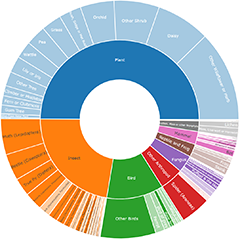Convoluted to brain-like [Brain jelly & look-alikes]
The fruitbody of a fungus in this group has irregular folds, sometimes looking like a piece of cloth that has been scrunched up but the fruitbodies may also have a more convoluted to brain-like appearance.
There is no stem, so if you have something convoluted on a stem go to https://canberra.naturemapr.org/categories/guide/1705?1=1.
Most commonly seen are the jelly-like fruitbodies of the genus Tremella, which you find on wood. They may be white, yellow, orange or brown.
Warning
As conditions become drier Tremella fruitbodies lose their jelly-like texture, soon feel like firm rubber and eventually may become solid and unpliable. With dryness the convolutions become less intricate. Rewetting restores the initial texture and shape.
If you find something convoluted to brain-like on soil you may have:
(1) A species of Hydnoplicata. The fruitbodies are fleshy to rubbery (never jelly-like) and dirty-white to pale brownish. They show gentle folds externally, but if cut often show much infolding. This genus is included with the truffles (https://canberra.naturemapr.org/categories/guide/1752?1=1).
(2) A cyanobacterium, such as Nostoc (https://canberra.naturemapr.org/species/9060), which is jelly-like and has a khaki to greenish colour when hydrated.
Announcements
There are currently no announcements.
Discussion
Unverified Convoluted to brain-like [Brain jelly & look-alikes]
Gelatinous, on wood – genus uncertain
Gelatinous, on wood – genus uncertain
Heterotextus peziziformis
Top contributors
- TimL 15
- KenT 11
- Teresa 10
- LisaH 10
- Hejor1 7
- Darcy 5
- Bushrevival 4
- trevorpreston 4
- Jek 4
- AaronClausen 3
Top moderators
- Heino1 48
- Teresa 17
- Heinol 15
- Heino 12
- KenT 12
- MichaelMulvaney 7
- Csteele4 6
- Pam 5
- Darcy 3
- WingsToWander 1





